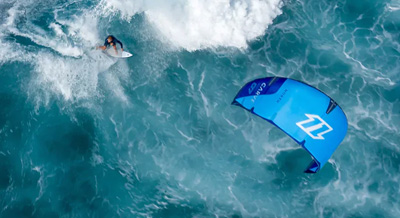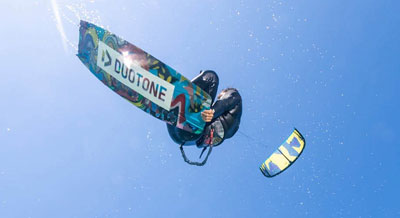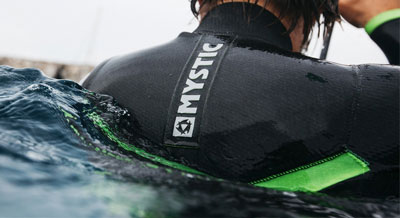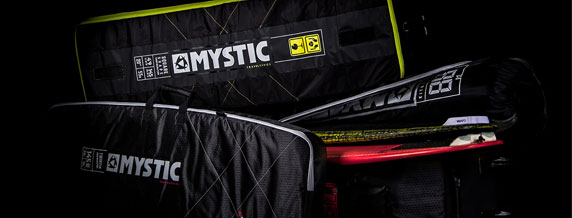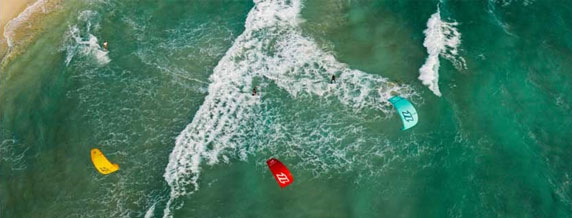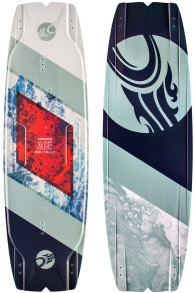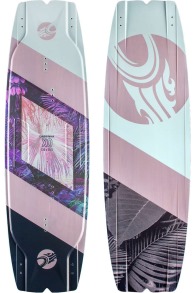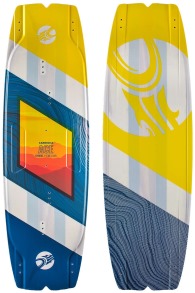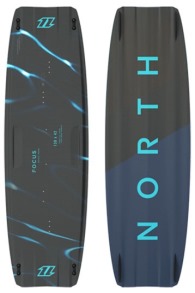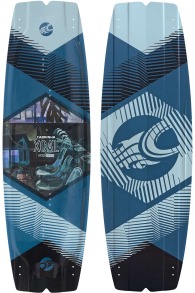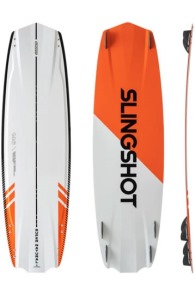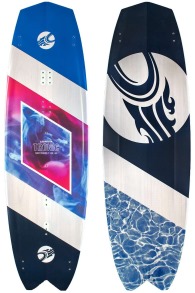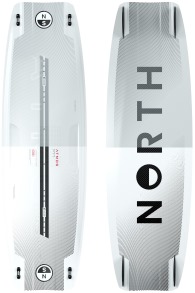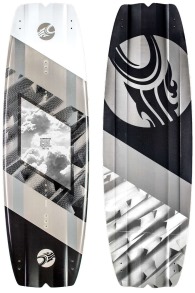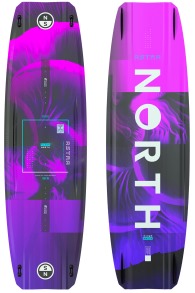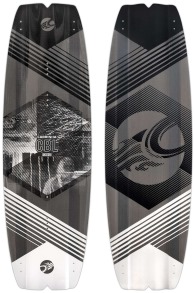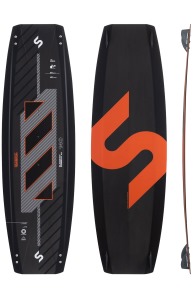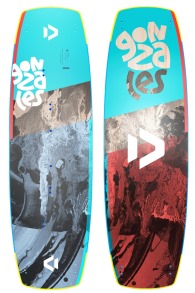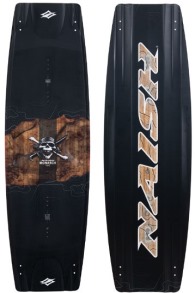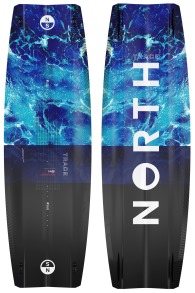Kiteboard - Twintip
When we talk about a kiteboard, we often refer to a twintip. A twintip kiteboard is a kitesurfing board that can ride in two directions without having to rotate it 180 degrees. Twintips are the most commonly used kiteboards because they eliminate the need for jibing. An additional advantage is that you can land fakie tricks and continue riding smoothly. This is a must for freestyle kiters. Even freeride kiters use twintips because of their playful nature and jumping capabilities. Twintip kiteboards come in many different shapes and sizes, depending on your weight, body type, riding style, and personal preference. Kitemana carries all the top brands, offering a wide selection of boards. Do you have a question about twintips or would you like assistance in choosing your new kiteboard? Feel free to call or email us. Read more »
Kiteboard - Twintip
When we talk about a kiteboard, we often refer to a twintip. A twintip kiteboard is a kitesurfing board that can ride in two directions without having to rotate it 180 degrees. Twintips are the most commonly used kiteboards because they eliminate the need for jibing. An additional advantage is that you can land fakie tricks and continue riding smoothly. This is a must for freestyle kiters. Even freeride kiters use twintips because of their playful nature and jumping capabilities. Twintip kiteboards come in many different shapes and sizes, depending on your weight, body type, riding style, and personal preference. Kitemana carries all the top brands, offering a wide selection of boards. Do you have a question about twintips or would you like assistance in choosing your new kiteboard? Feel free to call or email us. Read more »
Twintips at Kitemana
Buying twintips at Kitemana is very easy. We have all twintip brands in stock, suitable for beginners, advanced riders, and every discipline. Whether you are just starting or looking to take your skills to the next level, we have the perfect kiteboard for you. Our extensive range ensures that you find the ideal twintip that matches your riding style and preferences. At Kitemana, we understand that the right kiteboard can make a big difference in your experience on the water. That's why we offer a carefully curated selection of only the best brands, ensuring quality and performance. Our team is always ready to provide you with advice and help you choose the best twintip for your needs. On this page, you will find a number of frequently asked questions to make your search a bit easier.
Meest gestelde vragen bij het aanschaffen van een twintip:
- 1. What is a twintip?
- 2. What is the right size twintip for me?
- 3. What different types of twintips are there?
- 4. What effect do rocker, outline, and flex have on a twintip?
- 5. What influence does a single concave or a double concave have on the riding experience of a twintip?
- 6. What materials are used in a twintip construction?
- 7. Are there twintips specifically made for lightweight riders and/or children?
- 8. Which brands of twintips can I buy at Kitemana?
What is a twintip?
A twintip is a type of kitesurfboard widely used in the kitesurfing world due to its versatility and ease of use. As the name suggests, a twintip has a symmetrical design with two identical ends, allowing you to ride both forward and backward without changing foot position. This makes it ideal for big air, freestyle, and freeride kitesurfers who often want to change direction or perform tricks.
Twintips are usually shorter and wider than directional boards, with fins at both ends for extra grip and stability. They are designed to plane easily, ride comfortably, and perform well in various conditions, from flat water to small waves. Because of their user-friendly and versatile nature, twintips are the most popular choice for both beginners and advanced kitesurfers. They provide an excellent way to learn the basics of kitesurfing and to continue progressing.
What is the right size twintip for me?
The right twintip size depends on several factors. Your height and weight play an important role. The larger and/or heavier you are, the larger your twintip kiteboard should be. Another factor that determines your choice of the right kiteboard size is your skill level. If you are confident in riding upwind, a smaller twintip is more suitable because it is more maneuverable. If you are still practicing upwind riding or water starts, a larger twintip is better, as larger kiteboards plane earlier and offer more stability.
The right size of your twintip also depends on how strong the wind is at your home spot. The rule is: the stronger the wind, the smaller your twintip can be. If you often kite in light wind conditions, a larger kiteboard allows you to get on the water earlier. A smaller twintip in strong wind makes edging easier and enables more dynamic maneuvers.
bekijk hier onze verschillende kiteboards
twintips surfboards lightwind kiteboards secondhand kiteboards foil kiteboards
What different types of twintips are there?
Big Air Twintips
Big air twintips are specially designed for high jumps and maximum airtime. These kiteboards are often stiffer and have a unique shape that provides extra grip and control. They also typically have an explosive pop, allowing for powerful takeoffs. These twintips are ideal for kitesurfers aiming for spectacular airtime and huge megaloops.
Freeride Twintips
Freeride twintips are perfect for relaxed cruising, offering plenty of comfort and fun in all conditions. They are suitable for both beginners and advanced kitesurfers who prefer a true all-rounder. Freeride twintips usually have medium flex and not too much rocker. They make upwind riding easy, and they ride comfortably and knee-friendly through choppy water. Additionally, you can also jump well with a freeride kiteboard and land softly.
Beginner Twintips
Beginner twintips are designed with the needs of new kitesurfers in mind. They are usually softer and more flexible, providing a more comfortable and forgiving ride. These kiteboards make it easier to learn and enjoy kitesurfing without being too harsh when mistakes are made. Kiteboards for beginners often fall under freeride twintips.
Freestyle Twintips
Pure freestyle twintips are often more suitable for advanced riders. These kiteboards generally have a medium to high rocker and, due to their stiffness and straighter outline, offer a lot of pop for hooked and unhooked tricks. These kiteboards typically offer less riding comfort and softer landings. However, if performance is more important to you than comfort, a freestyle twintip will certainly provide more performance and sportiness. Freestyle twintips are often ridden with boots instead of straps. When purchasing, make sure that the inserts of the kiteboard are reinforced and suitable for boots to prevent breakage.
Lightwind Twintips
If you often kite in light wind conditions, buying a light wind kiteboard is definitely worthwhile. These twintips are larger and wider than other kiteboards and have a sharper outline. This gives the twintip a surface area that generates a lot of buoyancy and early planning. This means you need less power from your kite and can go upwind even in lighter winds. Because light wind kiteboards are also perfect for beginning kitesurfers, you can buy this type of board as your first kiteboard and continue to use it for light wind sessions as your skills improve.
What effect do rocker, outline, and flex have on a twintip?
Rocker
The rocker of a twintip describes the degree of curvature of the kiteboard from tip to tip. Kiteboards have a flat, medium, or high rocker. The flatter the rocker, the more water contact and buoyancy the kiteboard has.
Twintips with a flat rocker gain speed more quickly, especially in light wind conditions. Because these kiteboards offer a substantial surface area on the water, riding upwind becomes easier. You will often find a flat rocker on light wind boards. However, these boards feel less stable in choppy water and are harder to turn, making tricks more difficult to perform.
Conversely, there are twintips with a high rocker. Due to their smaller contact area with the water, they are very easy to turn. Tight turns are much easier, and poor landings are well compensated for with these boards. The downside is that upwind riding can be more challenging in light wind conditions because only a small portion of the board's edge contacts the water. Twintips with a high rocker are therefore very suitable for performance-oriented freestylers and wakestylers.
A twintip with a medium rocker combines the benefits of a relatively large contact area and length for buoyancy and upwind riding with high riding comfort in choppy water while still being maneuverable. Many big air, freeride, and freestyle twintips have a medium rocker. This makes these twintips versatile and popular among kitesurfers who don't want to stick to just one riding style.
Outline
The outline is the outer shape or circumference of a kiteboard. A straight outline can be distinguished from a curved outline. Straight outlines mean that a large portion of the kiteboard's rails are in contact with the water, giving a twintip good upwind capabilities. Additionally, you can apply a lot of pressure on the edge of the board, creating a lot of pop. However, a twintip with a straight outline is less easy to turn, which is noticeable during fast and dynamic maneuvers. The rounder the outline of a twintip, the easier the kiteboard turns. With a twintip with a curved outline, you can make very tight turns. Dynamic tricks are a lot of fun with these types of twintips, especially in strong winds!
Flex
The flex of a twintip can be soft, medium, or hard. Twintips with a soft flex are slower but offer a lot of comfort, especially in choppy water. However, at high speeds, soft kiteboards are less easy to control, and it is difficult to create decent pop with them.
On the other hand, a twintip with medium flex offers more control at higher speeds. Additionally, it rides very comfortably through choppy water, can generate good pop, and landings feel soft.
With stiffer boards, riding comfort is reduced in choppy conditions. Hard kiteboards are good for freestyle and wakestyle because they create maximum pop but can be tough on the knees as landings can be much harder.
What influence does a single concave or a double concave have on the riding experience of a twintip?
A single concave or mono concave channels water underneath the kiteboard. This effect gives a twintip better directional stability and better control at high speeds compared to a kiteboard without a concave. Additionally, riding upwind is easier with a twintip that has a single concave. You will usually find a mono concave on high-quality freeride twintips.
If a twintip has a double concave, these taper towards the center. This gives the kiteboard even more guidance and directional stability. The material feels much stiffer, making the kiteboard stiffer from the center. This results in better pop and makes edging easier. Consequently, you can generate more pop with a double concave twintip than with a mono concave twintip. Additionally, your landings will be softer as the water surface breaks. A double concave is often found in big air and freestyle twintips.
What materials are used in a twintip construction?
The construction of a twintip typically consists of a wooden core, which is then layered with fiberglass and epoxy to achieve its final appearance. The wooden core has the advantage of being a naturally very flexible and robust material. As a result, a twintip with a wooden core has a medium flex and offers a lot of comfort. A fiberglass construction is the cheaper option compared to a carbon construction.
Twintips that are fully or partially made of carbon are of higher quality but also significantly more expensive. Carbon has a very low weight, making carbon kiteboards surprisingly light. They are also much stiffer, which means you can generate a lot of pop with a carbon twintip. However, a stiff twintip is not particularly taxing on the joints. If you are looking for a performance-oriented twintip and price is not an issue, you will definitely be happy with a carbon twintip.
Are there twintips specifically made for lightweight riders and/or children?
Many kite brands design special twintips for lighter riders. These boards are shorter, narrower, and lighter than standard twintips. They also have a narrower stance. Since women are often lighter and smaller than men, these twintips are frequently marketed as "women's kiteboards" by manufacturers, such as the Soleil by Duotone, the Riptide by Brunotti, or the XO by Cabrinha. There are also special kiteboards for children that are narrower, smaller, and lighter than adult twintips, such as the Airush Livewire Junior kiteboard or the Brunotti Discovery JR Kiteboard. These twintips are perfectly tuned to the size and weight of children, making them easier to handle for young kitesurfers.
Which brands of twintips can I buy at Kitemana?
Airush: twintip and directional surfboards
Appletree: specialised premium directional surfboards only
Brunotti: twintip en directional surfboards
Cabrinha: twintip en directional surfboards
Carved: premium carbon twintip kiteboards
Core Kiteboarding: twintip en directional surfboards
Duotone Kiteboarding: twintip en directional surfboards
F-One: twintip en directional surfboards.
North: twintip en directional surfboards.
Lieuwe:Specialized premium handmade twintip kiteboards.
Naish: twintip en directional surfboards.
Ozone: twintip kiteboards
Reedin Kiteboarding: twintip en directional surfboards
Slingshot Kiteboarding: twintip en directional surfboards
Added to basket
| Subtotal | 0,00 |
| Shipping costs NL | 0,00 |
| Total (incl 0% VAT) | 0,00 |
You have no product(s) in you basket.
Weet je niet waar je moet beginner?
Contact our customer service for advice
Manage Cookie Consent
We like to give you the best experience and most relevant deals on our website, media and through our advertisements. To do that, we need to place cookies and collect some data. If you are ok with this, press the green accept button! For more information click here or change settings to your preference.
Functional
Always active
Analytics cookies
Advertising cookies
User data sharing
Personalization cookies

